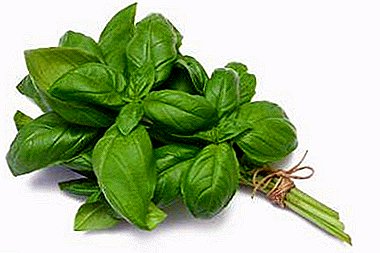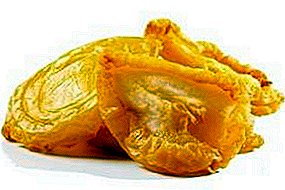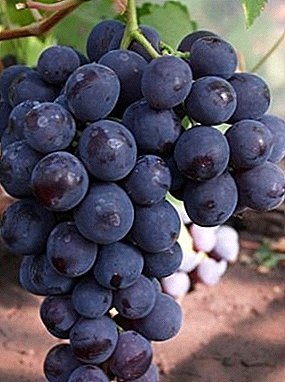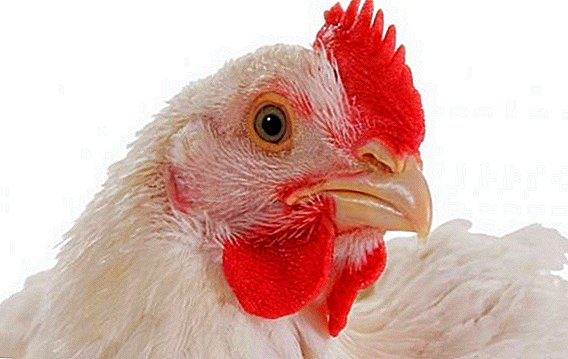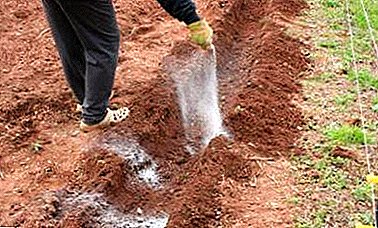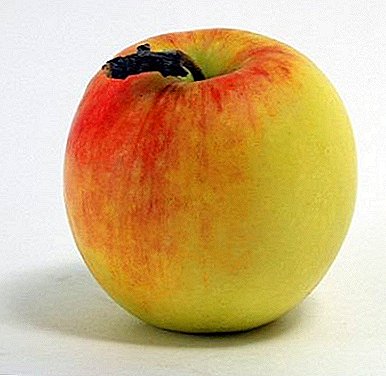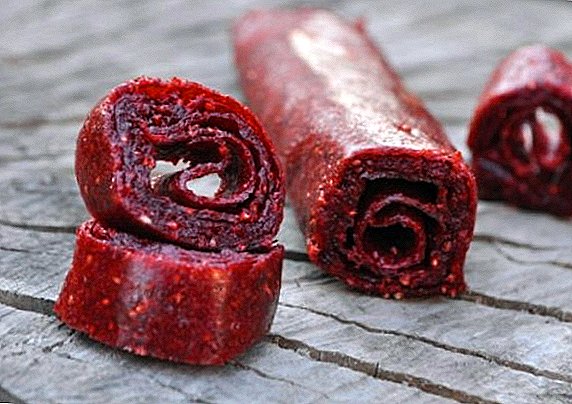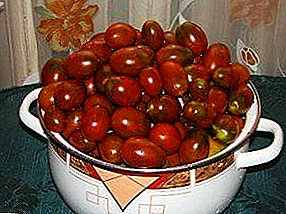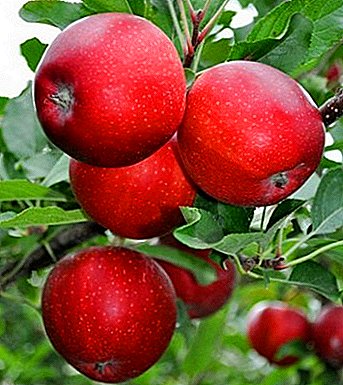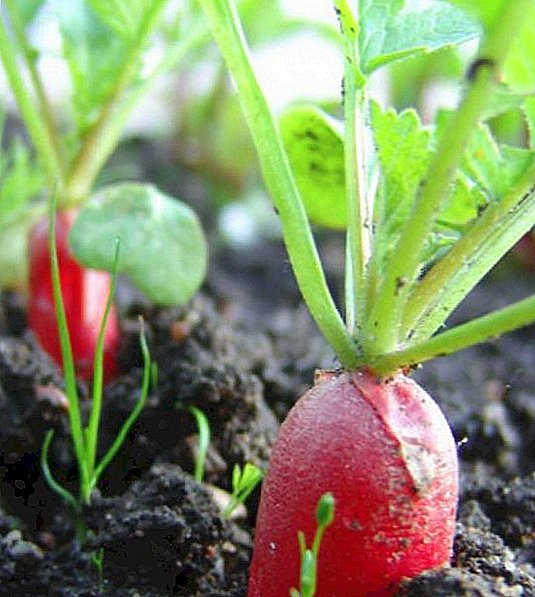 Radish is one of the most popular root vegetables on the domestic market, and if you still consider the possibility of growing it all year round, then there is no price for the plant at all. However, to get juicy and tasty root crops at any time of the year, it is worth taking care of suitable conditions for their growth and development.
Radish is one of the most popular root vegetables on the domestic market, and if you still consider the possibility of growing it all year round, then there is no price for the plant at all. However, to get juicy and tasty root crops at any time of the year, it is worth taking care of suitable conditions for their growth and development.
A properly designed polycarbonate greenhouse can help in this, and we will tell you about the nuances of its use for the cultivation of radish.
Greenhouse
Polycarbonate greenhouse - more reliable construction, rather than film shelter, and it can be used even in winter.
We recommend to read how to make a greenhouse from polycarbonate with your own hands.
However, if you want to grow radishes all year round, then you have to take into account some of the requirements for such a place of its growth.  First of all, these include:
First of all, these include:
- good stability of the structure, which should be taken care of even at the stage of designing the greenhouse;
- the presence of a ventilation system that will prevent the formation of high humidity after irrigation;
- the presence of a heating system, especially if you intend to use the structure during the cold season (it can be propane or electric: the choice depends on the size of the greenhouse, the cost of electricity, the equipment itself, etc.);
- correctly selected cassette material, which should not release harmful substances when interacting with other solutions used (if a cassette method of growing radish is provided);
Important! The optimal solution is the use of 40x40 cassettes in which 64 cells are provided, or a 35x36 capacity with 49 cells.
- high quality of the substrate in the greenhouse (the soil must be quite loose, fertile and well drained, and if desired, you can use a ready-made soil mixture intended for the cultivation of major crops);
- the organization of the irrigation system, which in the case of the cultivation of root crops in cassettes should be carried out by flooding.
Properly prepared polycarbonate shelter has several advantages over alternative greenhouse options for growing radish, these are:
- reliable, stable, streamlined frame;
- durability of use of the structure;
- resistance to snowfall and frost (up to severe frosts);
- esthetic appearance.
 In addition, if compared with more serious greenhouses, organized in industrial premises, the polycarbonate version will be much cheaper, and the result will be almost the same.
In addition, if compared with more serious greenhouses, organized in industrial premises, the polycarbonate version will be much cheaper, and the result will be almost the same.Sorta
Before choosing a variety of radish for planting in your greenhouse, decide how long you plan to grow it. Most often, constructing a polycarbonate greenhouse with all systems, its owner relies on year-round cultivation of plants, so if you have similar plans, then when choosing seeds you should pay attention to early and early varieties for growing indoors.
Find out how radishes are useful, how vegetables are used in traditional medicine, and how to grow radishes.
From the early ripening varieties, you can wait for the crop 20 days after planting, mid-season radishes will be ready for harvest in about a month, and later varieties will delight with the harvest only after 40 days.
If desired, varieties of different ripening period can be combined in the same greenhouse, which is even more preferable, since the radish harvest will be ready for harvesting all the time.
Among early hothouse radish greenhouse, with the highest ratings of experts, the following early ripening varieties can be identified:
- "Ultra Early Red". A very attractive red radish of round shape, with excellent taste and weight up to 15 g. In addition to the root crops themselves, they also use its green part, which is great for making soups and fresh salads. Maturing term 20 days.
- "Child" - A hybrid, juicy and slightly acute variety, characterized by very early ripening: the crop can be harvested already 16 days after planting.

- "18 days". An elongated, cylindrical root vegetable with a mild, very mild taste. As indicated in the title, 18 days are enough for full maturity.

- "Firstborn". Another hybrid early-ripening variety that will delight with juicy, sweet and large fruits (up to 35 g each) is already 16–18 days after planting in the greenhouse. It is highly resistant to cracking and gives a bountiful harvest: from 1 m² up to 3.5 kg of root crops can be harvested.

Did you know? Radish came to Russia thanks to Peter I, who delivered it to the state in the XVII century. According to historical data, he considered this bright root crop to be just a miraculous plant, able to warm the heart and give strength. True, at that time many did not share the views of the king, therefore real popularity came to the radish only in the XVIII century.
Popular early varieties of greenhouse radish are represented by the following varieties:
- "Early Red". It is characterized by high resistance to bolting and high yield.

- "French breakfast". Cylindrical fruits with high taste, which can be grown both in the greenhouse and in the garden. The ripening period is 22-27 days.

- "Heat". The classic representative of radishes: a pink-red root vegetable with a smooth surface and a weight of 25-30 g each. You can harvest a juicy and tasty harvest in 18-25 days after planting. Feels good both in greenhouse conditions and in the open field.

- Celeste - Dutch, hybrid, greenhouse variety of radish, characterized by good yield and excellent taste. The plant is unpretentious in growing and care.
 Of course, this is not all possible varieties suitable for growing in polycarbonate greenhouses, but in any case, when selecting seed, it is very important to consider its zoning and soil composition requirements, which is usually indicated by the manufacturer on the package.
Of course, this is not all possible varieties suitable for growing in polycarbonate greenhouses, but in any case, when selecting seed, it is very important to consider its zoning and soil composition requirements, which is usually indicated by the manufacturer on the package.Training
Before sowing radish in a greenhouse, it is very important to properly prepare the substrate, what they have been doing since autumn. It is not a secret that for abundant harvest the soil should be sufficiently nutritious, therefore mineral fertilizers are introduced into it in the form of superphosphate (40 g per 1 m²) and potassium chloride (15 g per 1 m²).
In addition, it should be characterized by neutral acidity, as the plant often suffers on acidic soils.
It will be useful for you to learn how to independently determine the acidity of the soil at the site, as well as how to deoxidize the soil.
If necessary (if the land is very depleted by previous crops), you can additionally fertilize it with organic matter, bringing in a bucket of compost per square meter of territory. After that, the soil should be dug, leveled and left for some time to organize the ridges a little later and plant radishes.
The second, equally important issue before planting radish in the greenhouse - the preparation of selected seeds. All of them should be quite large (about 3.5 mm) and completely healthy. In order to select the best quality specimens, you will have to perform the usual home sorting, sifting all the seed through a 2 mm sieve.  Those that remain in it, you can safely use for planting, soaking before that for several days (just wrap in wet gauze, keeping it wet all the specified time).
Those that remain in it, you can safely use for planting, soaking before that for several days (just wrap in wet gauze, keeping it wet all the specified time).
Ready for planting seeds should have a few sprouts, and as soon as they appear, they are washed and lowered into a growth stimulator solution for several hours. After that, all planting material is washed again and left to dry completely on a cloth. Everything, it is possible to land a radish on the place allocated for it in the greenhouse.
Did you know? In order to make the wells prepared for seeds as accurate as possible, a paper tray from under the eggs can be used as a marker, squeezing them out on the ground surface. That is, to get the perfectly correct "houses" for each seed it does not need to suffer for a long time with manual marking.
Landing
If your polycarbonate greenhouse is equipped with a good heating system, then you can grow radish all year round, sowing it at any time. However, the best option is considered to be the spring period (March-April), especially if you grow a root vegetable for yourself.
With the arrival of the first heat and the increase in daylight hours, you will not have to spend a lot of money on heating and lighting facilities, which makes growing plants more profitable.
The process of planting radishes begins with loosening the soil and organizing suitable beds, for which you can use the cord to mark grooves located 7-10 cm apart from each other, and make centimeter grooves in each of them (this will help a thin planochka).  In the resulting grooves, the seeds are placed at a distance of 1-2 cm from each other, then sprinkling them with light soil. Immediately after planting, plantings are watered from the sprayer and left to grow, creating all the necessary conditions for this: temperature and light.
In the resulting grooves, the seeds are placed at a distance of 1-2 cm from each other, then sprinkling them with light soil. Immediately after planting, plantings are watered from the sprayer and left to grow, creating all the necessary conditions for this: temperature and light.
When growing radish, you may encounter some problems and bitterness, as well as how to deal with pests and diseases of radish.
So that the seedlings feel good, the temperature during their landing should be within + 10 ... + 12 ° C, and then rise to + 16 ... + 18 ° C (ideal for germination). As soon as the first cotyledon leaves appear, the temperature indices immediately drop to + 8 ... + 10 ° C and are maintained at this level for three days.
As for the lighting, then the ideal indicators will be the values in 1200-1300 lux, with a light day at 12 o'clock. In winter or early spring landing, it is mandatory to highlight the LED or fluorescent lamps.  Similar conditions should be observed when growing radishes in cassettes, and the difference is only in a more convenient way of planting (nothing needs to be marked up, it is enough just to put the prepared soil mixture into small holes and place the roots in it).
Similar conditions should be observed when growing radishes in cassettes, and the difference is only in a more convenient way of planting (nothing needs to be marked up, it is enough just to put the prepared soil mixture into small holes and place the roots in it).
Important! Maintain coverage for more than 12 hours in a row is not worth it, since the radish may well shoot arrows.
Care
To obtain a good result in the form of a bountiful harvest, it is simply unacceptable to ignore the requirements for caring for a radish planted in a greenhouse. As with the cultivation of other garden crops, there are several main aspects to this issue:
- Watering. Radish grows well only in a moist substrate, so the soil should not be allowed to dry out. The result of this omission will be a significant yield loss. With the cassette growing method, watering should be done only from below, through special drainage holes, moistening the substrate up to 10-15 cm. In order to less moisture evaporated, sprinkle the soil with peat or humus.

It will be useful for you to read about how to make drip irrigation from improvised means or plastic bottles with your own hands, and also learn about the advantages of automatic watering.
- Humidity. Radish does not like high humidity, as in this case the risk of typical diseases increases several times (the most common "black leg"). To exclude the possible manifestation of the disease, it is very desirable to ventilate the greenhouse after each watering.
- Top dressing. The fertilizer of the planted plants is performed mainly when not enough nutrients were introduced into the soil in the autumn (before planting). Additionally, it is possible to enrich the substrate with the help of superphosphate diluted in water, urea or wood ash, and nitrogen fertilizing will also be useful. The latter is made on the basis of a calculation of 20-30 g per 1 square meter of territory.
- Weeding and thinning. A few days after planting radishes, it will already need to be thinned out, otherwise, instead of the growth of root crops, you will observe an increase in the green mass of the plants. In the future, need a few more weeding and compulsory loosening of the soil.
- Disease prevention. To avoid the appearance and development of the most common radish ailments, preventive treatments should not be excluded. Alternatively, young plants can be sprayed with a solution of wood ash and laundry soap in a 2: 1 ratio. In this way, you can protect your radish from powdery mildew and the already mentioned “black leg” by additionally scaring away cabbage moth, cruciferous midges and caterpillars from it.
- Wintering. If there is a heating system in the greenhouse, wintering should not become a problem, because for plants that are warm, there is no difference what is happening on the street. However, when using this structure only in a relatively warm season and without heating, you will have to take care of additional shelter of sprouts in early spring and late autumn (usually polyethylene is stretched over the beds).
Simply put, putting in a relatively little effort, you get a good harvest of tasty and healthy home-made radish, ready to harvest.
Collection and storage
By harvesting, you can go 30-45 days after planting the crop, when the radish grows to two centimeters or a little more. To delay with this is not worth it, because the plant can go to the arrow and become overly rigid, unsuitable for food purposes.  Harvesting is done in a selective manner, leaving small fruits in the garden to ripen. After all the harvesting has been done, it remains only to prepare the soil for the next planting cycle, because this crop can be grown in a greenhouse made of polycarbonate all year round.
Harvesting is done in a selective manner, leaving small fruits in the garden to ripen. After all the harvesting has been done, it remains only to prepare the soil for the next planting cycle, because this crop can be grown in a greenhouse made of polycarbonate all year round.
Harvest should be stored in a cool room, pre-packaged in packages.
Using a polycarbonate greenhouse for growing radishes, you will notice the benefits after the first harvest of root crops, and it does not matter if you grow them for your own use or for sale. All you need to succeed is a little time and patience, and the result of your efforts will be a crispy and fragrant radish grown without nitrates.


